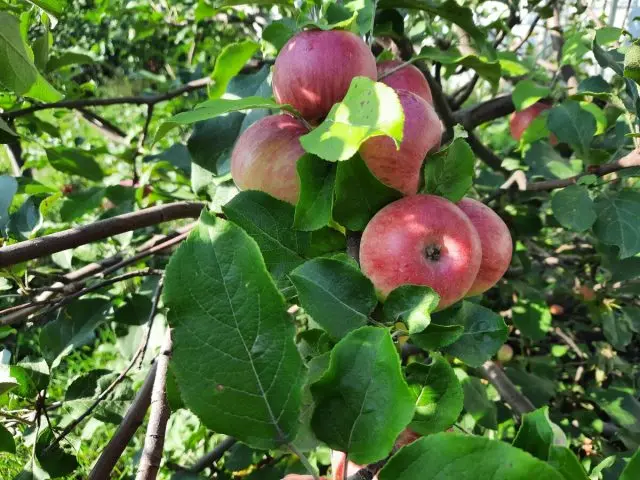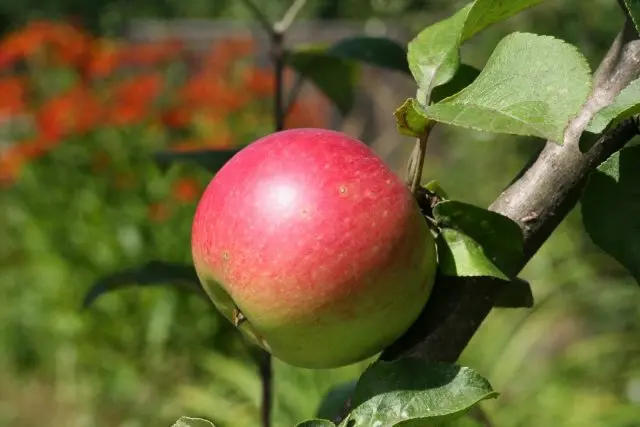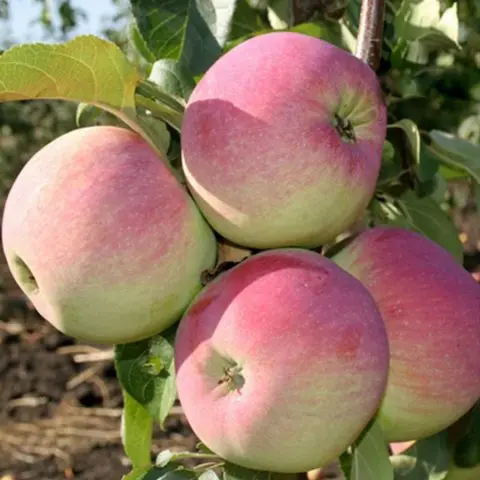Contents
The apple tree is the most common and unpretentious fruit tree, which, with the development of breeding technologies, has been adapted for growing under any conditions. The bred hybrids are many times superior to the original varieties. The proof can be the Freshness apple tree, a feature of which is resistance to adverse climates and increased immunity to scab.

Freshness apple tree is suitable for cultivation in intensive orchards
History of breeding
Apple tree Freshness is considered relatively young, because the hybrid was born in the mid-70s. A group of scientists from the All- Research Institute of Fruit Crops Breeding, which included E. N. Sedova, V. V. Zhdanova and Z. I. Serova, worked on breeding a new variety.
Hybridization was carried out on the basis of the genetic material of the Antonovka-krasnobochka variety and the complex hybrid PR12T67 obtained from F2 M. Floribunda and “American” Welsey.
In 1985, fruits first appeared on the apple tree of the Freshness variety, and by 1994 the hybrid was ranked among the elite and sent for state testing. Apple culture was introduced into the State Register in 2001.
Description of the apple tree Freshness with a photo
From the photo and description of the Freshness apple variety, you can understand that the fruit tree has many advantages, thanks to which it has become popular among gardeners in the central regions. The hybrid is valued for its unpretentiousness and resistance to scab, which significantly reduces crop care.
tree appearance
Apple tree Freshness is a medium-sized fruit tree with a fast pace of development. Despite the fact that the culture reaches a height of about 4 m, its crown is compact, rounded in shape. The main branches are curved, and the shoots are directed upwards. The bark of the trunk and branches is smooth, brown. The lateral branches are cranked, medium in thickness, their color is light brown, and there is a slight pubescence on the tops.
Small lenticels can be seen on the stems. The kidneys are conical, appressed and smooth. Leaf plates are located on long, slightly fleecy petioles. They are large in size, broadly ovoid in shape with crenate edges and twisted tips, rich green in color. The surface of the leaves is glossy, slightly concave, wrinkled with clearly visible veins.
The apple tree blooms. Freshness is plentiful. Inflorescences form a thyroid type of 4-6 buds of a white-pink hue. The flowers are medium-sized, they are elongated saucer-shaped.

You can determine the apple tree Freshness by the curves of the main branches growing at an acute angle
Description of fruits
The fruits of the Freshness apple tree are small, with an average weight of about 130-150 g. In rare cases, they can reach 200 g. Their shape is round, flattened, broadly ribbed. The skin is oily, with a glossy sheen. During technical maturity, the fruits have a greenish-yellow hue with an integumentary bright red streaked color on the side of the sun. Subcutaneous dots are yellow.
The stalks on which the apples are located are straight with an average length and diameter. Funnel without rust. The calyx is closed, the saucer is wide and deep, striated in shape. In the center are medium closed chambers with dark brown seeds. The heart is quite large.
On the cut, the pulp is very juicy, with a slight greenish tinge, dense, fine-grained. On impact, the fruit breaks easily.

Fruits develop well under any climatic conditions.
Characteristics of the apple tree Freshness
The hybrid variety Freshness has a number of positive characteristics, so gardeners of the middle lane prefer this particular apple tree. It is unpretentious and gives a stable annual harvest.
Palatability
The palatability of the fruit is good, the tasting score is 4,3 points. The aroma is mild, inherent in apple crops.
Hybrid Freshness is classified as table varieties because of the sweet-sour taste, and not for dessert.
Apple ripening dates Freshness
Apple-tree Freshness is an early-growing variety, but in terms of ripening it is classified as late winter. Technical maturity comes by mid-September, during this period you can start picking Freshness apples from the tree. Without falling, the fruits can be on the branches until November.
After planting, a young tree begins to bear fruit in the ninth year. When grafted to the main crop, the first apples can form as early as 3-4 years of age.
Productivity
Under normal growing conditions, up to 45 kg of fruits can be obtained from one Freshness apple tree. From ha, the yield can be about 150 c.
Winter hardiness of apple tree Freshness
Apple-tree Freshness has good winter hardiness. The variety easily tolerates temperature changes and winters well in the middle zone.
Apple Pollinators Freshness
Self-pollination of the apple tree Freshness is marked as low. In order for the culture to abundantly form ovaries and the yield is high, it is necessary to have a number of growing pollinating trees. These include varieties of late apple trees.
Where is grown
According to reviews, the apple variety Freshness easily tolerates adverse weather conditions, so this hybrid is chosen for cultivation in the Moscow region and in the middle lane. It is also possible the cultivation of culture in the southern regions.
Disease resistance
The immunity of the apple tree Freshness is quite strong. The culture has good resistance to infection by fungal and bacterial diseases. The hybrid is especially valued precisely due to the high resistance to all five races of scab, which is laid down at the genetic level.
Advantages and disadvantages
Like all fruit trees, the Freshness apple tree has a number of advantages and disadvantages.

Fruits of the apple tree Freshness has an excellent presentation
Pros:
- a compact tree allows you to grow a crop in a small area;
- winter hardiness;
- stable yield;
- high keeping quality of fruits;
- undemanding to care;
- good presentation;
- fruits easily tolerate long-term transportation.
Cons:
- needs to be fed to maintain a stable crop;
- medium taste, which makes the variety table, not dessert.
Planting an apple tree Freshness
The timing of planting an apple tree Freshness depends on weather conditions and on the region. It is recommended to carry it out in the spring, approximately from the second half of April. It is allowed to land in open ground in the fall, a month before the first frost.
The site is chosen illuminated with deep groundwater. The landing pit is prepared in advance. They dig it up to a depth of 70 cm, about 1 m in diameter. At the bottom, a drainage layer is formed from medium crushed stone or expanded clay. Then the soil mixture is poured and the seedling is placed on top, straightening its roots. The remaining soil is filled up so that the root neck is located 5 cm above the ground. Lightly tamp and carefully shed the seedling.
To prevent the soil from drying out quickly, you can mulch the root zone.
Care instructions
All fruit trees consistently produce a good harvest if you follow the care recommendations, which consist of watering, fertilizing and pruning.
Watering is required to be done regularly, especially in hot weather. It is carried out from the beginning of the appearance of the first ovaries until the technical maturity of the fruit. A tree needs at least 10 liters of water.
The freshness apple tree reacts perfectly to top dressing. Particular attention should be paid to soil fertilization in the first 2-3 years after planting. At this time, nutrient compositions are introduced into the soil four times during the growing season:
- spring (mineral fertilizers);
- during the flowering period;
- after flowering (phosphorus and potassium compounds);
- autumn (complex top dressing);
Pruning is carried out to a greater extent for the formation of the crown, in order to prevent thickening of the crown. Sanitary cleaning is carried out as needed, as a rule, it consists in removing old, diseased and damaged branches.
Collection and storage
You can start harvesting the Freshness apple tree at the end of summer. However, the beginning-mid-September is still considered a favorable time. There is no need to completely remove the fruits from the tree, since they are not prone to shedding.
Fruit keeping quality is high. Freshness apples can be stored for up to six months without losing their original qualities, provided that the temperature regime and acceptable air humidity are observed.
Conclusion
Apple tree Freshness definitely deserves attention from novice gardeners. This hybrid is characterized by unpretentiousness, good yield and fruit versatility. And thanks to its resistance to scab, the culture easily tolerates a rainy summer.









